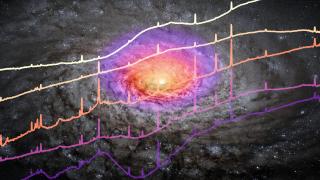Andonie, Carolina; Alexander, David M.; Greenwell, Claire; Puglisi, Annagrazia; Laloux, Brivael; Alonso-Tetilla, Alba V.; Calistro Rivera, Gabriela; Harrison, Chris; Hickox, Ryan C.; Kaasinen, Melanie; Lapi, Andrea; López, Iván E.; Petter, Grayson; Ramos Almeida, Cristina; Rosario, David J.; Shankar, Francesco; Villforth, Carolin
Referencia bibliográfica
Monthly Notices of the Royal Astronomical Society
Fecha de publicación:
1
2024
Número de citas
16
Número de citas referidas
16
Descripción
In the standard quasar model, the accretion disc obscuration is due to the canonical dusty torus. Here, we argue that a substantial part of the quasar obscuration can come from the interstellar medium (ISM) when the quasars are embedded in compact starbursts. We use an obscuration-unbiased sample of 578 infrared (IR) quasars at z ≈ 1-3 and archival Atacama Large Millimetre/submillimetre Array submillimetre host galaxy sizes to investigate the ISM contribution to the quasar obscuration. We calculate star formation rates (SFR) and ISM column densities for the IR quasars and a control sample of submillimetre galaxies (SMGs) not hosting quasar activity and show that: (1) the quasar obscured fraction is constant up to $\rm SFR\approx 300 \: {\rm M}_{\odot } \: yr^{-1}$, and then increases towards higher SFR, suggesting that the ISM obscuration plays a significant role in starburst host galaxies, and (2) at $\rm SFR\gtrsim 300 \: {\rm M}_{\odot } \: yr^{-1}$, the SMGs and IR quasars have similarly compact submillimetre sizes ($R_{\rm e}\approx 0.5{\!-\!}3\,\mathrm{ kpc}$) and consequently, the ISM can heavily obscure the quasar, even reaching Compton-thick ($N_{\rm H}\gt 10^{24} \rm \: cm^{-2}$) levels in extreme cases. Based on our results, we infer that ${\approx} 10{\!-\!}30~{{ \rm per\ cent}}$ of the IR quasars with $\rm SFR\gtrsim 300 \: {\rm M}_{\odot } \: yr^{-1}$ are obscured solely by the ISM.
Proyectos relacionados

Actividad Nuclear en Galaxias: una Perspectiva 3D del Núcleo y su Entorno
Nuestro proyecto puede dividirse en dos líneas principales de investigación. En primer lugar, el estudio de los vientos producidos por cuásares luminosos oscurecidos y del impacto que estos tienen en sus galaxias anfitrionas (retroalimentación del AGN). Para ello hemos obtenido observaciones en el óptico e infrarrojo cercano con el Gran Telescopio
Cristina
Ramos Almeida